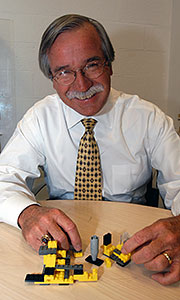Clicking together a small, safe nuclear power plant
Building a nuclear power plant can take decades—unless you follow a plan devised by MIT Professor Andrew Kadak of nuclear engineering. He likens his approach to building with Lego blocks: a small, meltdown-proof power plant would be made by “clicking together” prefabricated modules at building sites, cutting traditional construction time and costs in half.
While not quite as simple as building with Legos, the “plug-and-play” approach to construction coupled with the small size of the reactor could revolutionize the way nuclear plants are built. “If this works, the economic obstacle to building new nuclear plants will be removed,” said Kadak.
Nuclear power is in the limelight as a clean option for generating electricity, heat and even hydrogen. But the power plants of the future are likely to be different—small, safe and built by the dozen throughout energy-hungry countries. One promising candidate is the pebble bed high-temperature reactor in which uranium fuel is encased in billiard ball-sized graphite pebbles that cannot get hot enough to melt and are prepackaged for long-term disposal without reprocessing.
For the past decade, Kadak and others have been aggressively pursuing this technology. Tsinghua University in Beijing has put a demonstration plant through its paces, and China and South Africa are building full-size prototypes (about 160 MWe).
But for real success, the technology must be cost competitive. With a small plant like the pebble bed, the per-kilowatt cost would be high using the traditional approach of custom building each plant on site. Kadak’s cost-cutting idea is prefabrication. Sections of the plant would be made in factories, then shipped to the site and assembled. Nuclear submarines are now built using this approach, and the cost savings have been significant.


